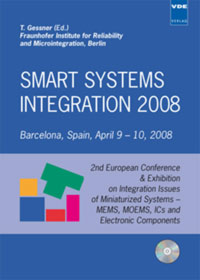Evaluation of a low cost piezorresistive material for high resolution tactile sensors
Conference: Smart Systems Integration 2008 - 2nd European Conference & Exhibition on Integration Issues of Miniaturized Systems - MOMS, MOEMS, ICS and Electronic Components
04/09/2008 - 04/10/2008 at Barcelona, Spain
Proceedings: Smart Systems Integration 2008
Pages: 3Language: englishTyp: PDF
Personal VDE Members are entitled to a 10% discount on this title
Authors:
Castellanos, Julián; Navas-González, Rafael; Vidal-Verdú, Fernando (Electronics Dpt., University of Málaga, Málaga, Spain)
Ochoteco, Estíbalitz (New Materials Dpt., Cidetec, San Sebastián, Spain)
Abstract:
Tactile sensors are basically arrays of pressure sensors that provide tactile images. They are demanded in applications where unstructured environments or uncertainty are present like minimal invasive surgery, robotics, rehabilitation, virtual reality, telepresence, or industrial automation. Although there are implementations of tactile sensors based on piezoelectric materials, on capacitive transduction, or on optical principles, most are based on piezorresistive materials. The reason is that they allow the fabrication of flexible sensors with a large area, as required for applications oriented to manipulative tasks with grippers or hands of robots. However, piezorresistive tactile sensors in the market (Tekscan , Peratech, Interlink Electronics) are built with expensive materials. For instance, the Tekscan technology uses a silver conductive ink on a plastic substrate plus a pressure sensitive material and the technology of Peratech uses polymers doped with particles of silver as an electroactive material. CIDETEC, has recently developed a flexible plastic sensor from conductive polymers (in cooperation with IKERLAN) based on the use of conductive polymer inks as active material. The policonjugated structure of these materials is not able to drive any electrical current itself, but the oxidized polymer can. The spin-coating of flexible plastic films of polietilentereftalato (PET) with these conductive inks results in a flexible conductive film on flexible plastic substrates. A low resolution sensor with 1cm interspacing has been built with this technology and successfully applied in the automotive sector. This material is aimed to be used now to build high resolution tactile sensors for robotics. Different questions arise since the area of the electrodes is much smaller and they are much closer to each other. This paper evaluates the performance of a tactile sensor that consists of an array of 16 x 16 electrodes with 2.54mm of interspacing that is covered with this smart material.


